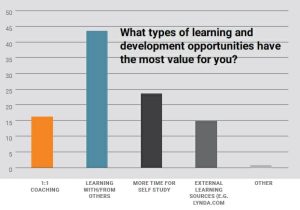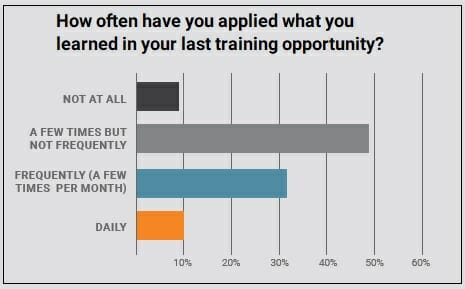If you ever want to know the truth about something, do an anonymous survey.
Case in point: When 1,000 U.S. learners were anonymously surveyed about their feelings on the corporate learning available to them, they didn’t beat around the bush. Learners described their learning opportunities as everything from “forced” to “haphazard” to “repressive”; more than one learning program was called “a joke.”
Ultimately, 60% of respondents used aggressively negative language to describe the learning opportunities available to them. The other 40% of responses, while not as strongly worded, barely qualified as positive (unless being described as “adequate” or “satisfactory” have resoundingly upbeat connotations that we’re unaware of).
Learning programs are flatlining. Which is too bad, because learners overwhelmingly see a positive link between their own development and their organization’s bottom line.
Luckily, the surveyed learners also weighed in on what they felt was missing from current learning opportunities, which types of learning they believe would work best for mission-critical training topics, and what’s needed for corporate learning to be the career-growing, organization-strengthening, goal-achieving program that L&D professionals certainly want it to be. And learners are very clear about what they need to succeed.
Collaborative learning
 Learners are hungry to step away from isolated, individual learning and step into collaborative environments that better leverage the insights of their peers and mentors. Collaborative learning, defined as “learning with/from others,” was the most-preferred method of learning for respondents, regardless of the type of learning last delivered to them by their organization.
Learners are hungry to step away from isolated, individual learning and step into collaborative environments that better leverage the insights of their peers and mentors. Collaborative learning, defined as “learning with/from others,” was the most-preferred method of learning for respondents, regardless of the type of learning last delivered to them by their organization.
What is it that learners feel they will get from collaborative learning that they aren’t getting from traditional corporate learning?
To answer this question, we must first recognize that there is a disconnect between what people define as collaborative and what the industry has sometimes labelled as such. Too often, and especially within online learning environments, table-stakes interactive features such as liking and commenting are said to satisfy learners’ social needs. Merely liking and commenting do not a true collaborative environment make!
Collaboration can’t be an add-on
For learning to be collaborative, it must be structured that way from the start; collaboration is not the result of an entry-level technology feature added to otherwise individually-lead learning. Collaborative learning is built around teamwork, involves in-depth peer feedback and makes it easier for learners to recognize (and be recognized as!) leaders within their own peer groups. In this way, collaborative learning mirrors the reality of learners’ day-to-day life as an employee, where they are often working on projects as part of a larger team, solving business problems together with peers, and connecting with and learning from others in real time.
Global teams that participate together in collaborative online learning may see the highest increases in performance. This is because online collaborative environments help learners overcome the physical distances that otherwise make it difficult to emotionally invest in unseen team members. Instead of playing time zone tag, teams can focus on solving specific problems together regardless of geographic location. For example, in the forums someone in Africa might be in a discussion thread with someone in Latin America, in an instantaneous and real-world way. In ye olde instructor-led model, with each of them in a classroom in their individual regions, there would not be that opportunity.
The data is clear: if you want a high-performing team, help learners connect with each other in new and meaningful ways. Create environments in which learners are working together to accomplish job-related assignments, in which problem-solving is cohort-based, and in which learners can learn from each other – just like they do when at work.
Leadership training lacking
Overall, surveyed learners reported a lack of confidence in their organizations’ ability to accomplish critical initiatives. This was due in part to the perception that their learning culture failed to professionally develop employees, particularly in the case of people skills like leadership, which survey respondents called out the most important “business critical” skills needed in their organizations today.
Any critical business initiative relies on people to move it forward. Leadership and related soft skills are a top way to achieve critical initiatives and build cross-role skill sets that continue to improve over time and on yet-unknown future initiatives.
The thing about people skills like leadership is that they are best learned from, well, people. Who would you rather learn soft skills from: a computer-programmed algorithm or a live mentor? Fortunately, learners no longer have to choose. When designed collaboratively, online learning simulates mentorship by allowing learners to connect with peer leaders around the world. It also allows businesses to “cascade” the details of enterprise-wide strategic change initiatives in an engaging manner to everyone in the company.
Studies have shown that millennial employees, who now make up the majority of America’s workforce, want to be emotionally invested in the organization and its goals in order to do their best work and to stay with the company long-term. Actively fostering learners’ professional and leadership skills results in highly-engaged employees that are more invested in the company at large.
Simply put, investing in learners leads to invested learners and critical initiative success. There is little replacement for employees who truly care about and are invested in the success of their organization, and employees simply won’t invest in an organization that doesn’t invest in them, first.
They don’t see your training as relevant
Ouch: Nearly three-quarters of surveyed learners rated their organization’s learning culture as less-than-useful.
It’s no wonder, with only about half (47%) of survey respondents saying that they had applied the learning from their last professional development opportunity “a few times but not frequently” at work. Nearly 10% said they weren’t applying the learning on the job at all, with a mere 11% said they used what they’d learned daily.
Professional education that isn’t relevant and applicable wastes employees’ time and drains company resources. Even worse, it discourages learners and gives them two negative impressions: that their organization isn’t knowledgeable about what skills are needed for business success and that the organization isn’t really invested in their individual development.
Learning professionals have heard over and over that relevant and immediately applicable education is a necessity for corporate education programs to yield tangible business results. Yet these survey results reveal that this mantra either hasn’t sunk in, or L&D hasn’t figured out the reality of what makes content relevant. Learners are still dissatisfied with the applicability of what they’re learning, and the lack of usefulness is turning them against their organization’s learning culture in a big way.
The results of our anonymous survey may be hard to swallow for some (sorry, L&D!), but many learning professionals are likely not surprised to hear that, according to learners, their learning program is ineffective.
Fortunately, the answers to learners’ complaints are clear: provide relevant job-related leadership programs via truly collaborative, peer-based learning. Then their performance, organizational loyalty, and ability to support business critical initiatives will increase exponentially. Learners are ready and eager for learning cultures to change, and with our survey, they’ve definitely told us how.
